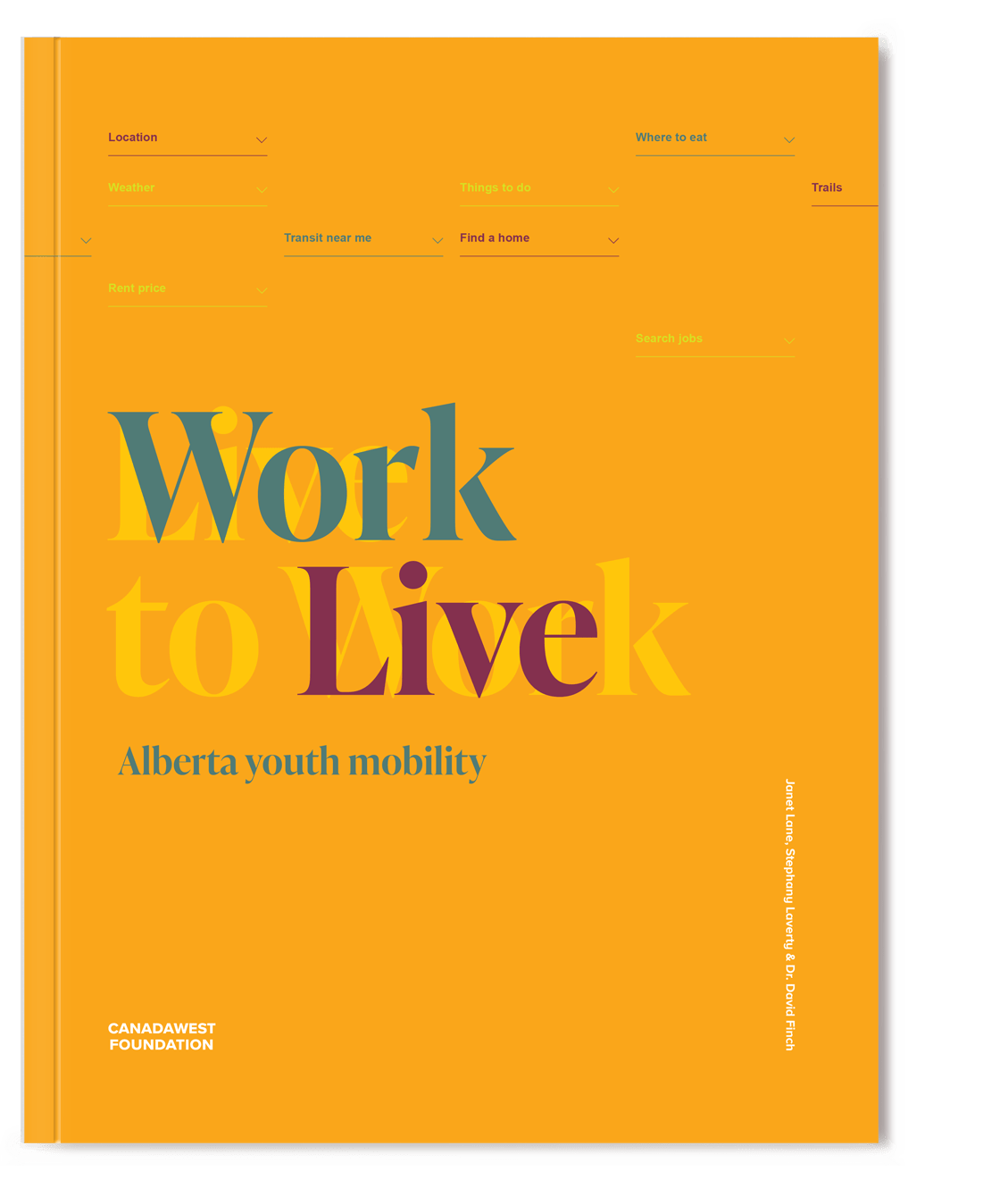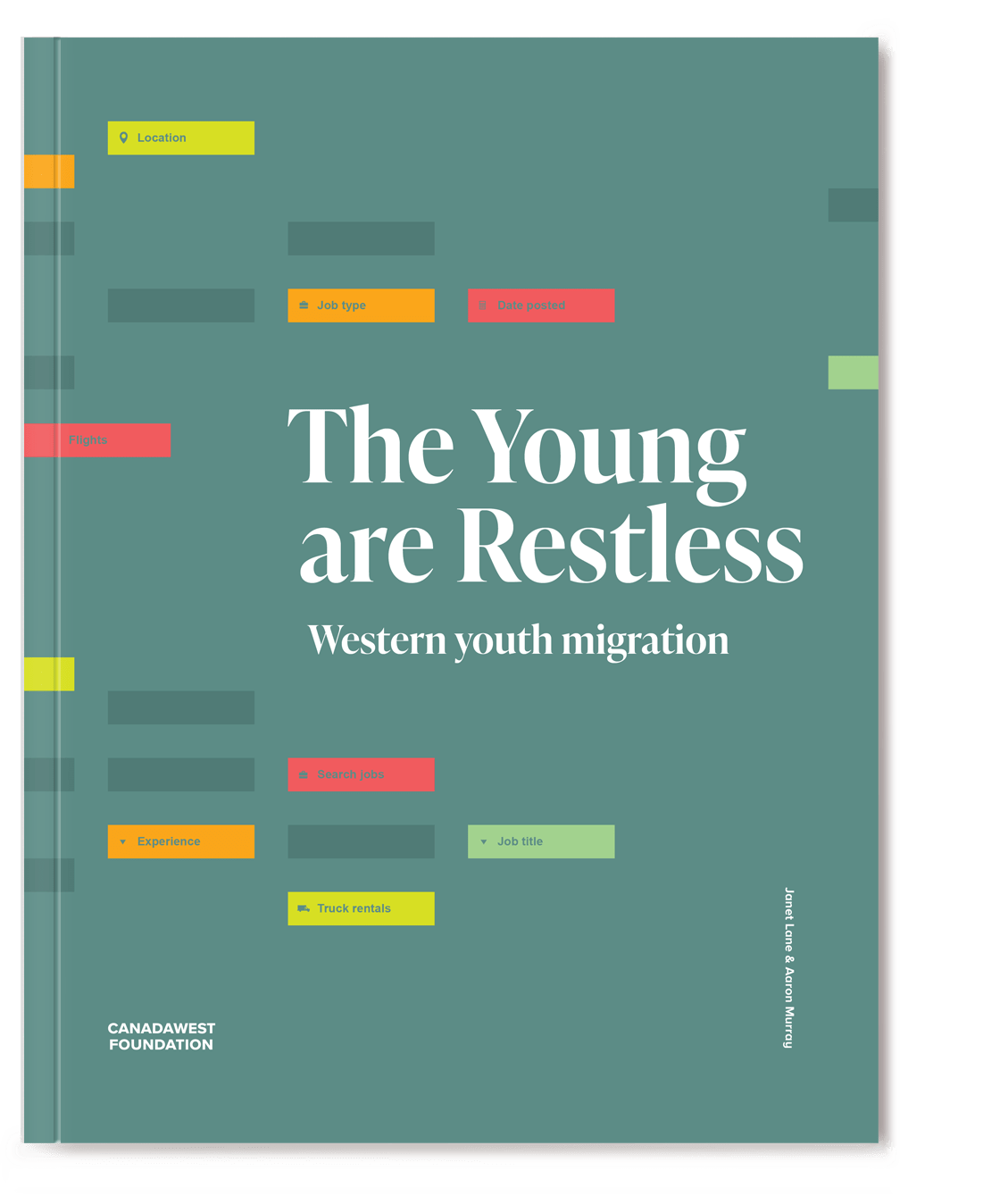Work to Live: Alberta youth mobility
Janet Lane, Stephany Laverty and Dr. David Finch
Two new reports by Canada West Foundation examine interprovincial youth mobility trends in western Canada. Work to Live: Alberta youth mobility and its companion piece The Young are Restless: Western youth migration examine the how and why of migration patterns and recommend ways to attract and retain youth.
 |
Work to Live Alberta youth mobility Read the full report |
 |
The Young are Restless Western youth migration Read the full report |
Project funding provided by Prairies Economic Development Canada and Calgary Economic Development.
Executive summary
After decades of youth moving to Alberta, often to take advantage of oil booms, the trend reversed in 2016. For the first time since 1988, more youth aged 15-29 moved out of the province than moved in. Over the next five years, Alberta’s net out-migration of youth aged-25-to-29 was 1,133 per year. Admittedly this figure represents just two per cent of the cohort, but because there were fewer youth in the age-group behind them, Alberta had nine per cent fewer 25-29-year-olds in 2021 than in 2016. Combined with Alberta’s aging population, this trend of more young adults leaving the province than moving to it is troubling.
While Alberta’s net youth migration has ebbed and flowed with boom-and-bust cycles in the oil and gas sector, over the last 50 years growth averaged about 8,000 youth per year. Despite ups and downs in the sector, Alberta could always expect youth would return to the province with the next boom. However, the world has changed and so too has the oil and gas sector. Alberta’s economy and communities are in transition.
Alberta has a lot to offer youth – quality education and training pathways; diverse career opportunities; a booming tech sector; world-class outdoor adventures; abundant parks and nature trails; fabulous arts and entertainment; vibrant cities; a responsive non-profit sector; affordable housing; competitive sports teams; and some of the best healthcare in the country. Despite the compounding effects of the global energy price crash and the COVID-19 pandemic, Alberta’s economic and fiscal situation has changed rapidly again as oil prices have risen and the royalty regime collects more revenue. Alberta is set to lead Canada’s GDP growth for the next two years. Tech firms in the province are breaking venture capital investment records and significant advancements in clean technology and non-energy sectors are further driving economic diversification. The problem to solve, then, is how to keep Alberta-born youth in Alberta, how to attract youth to Alberta from outside the province and how to retain Alberta youth once they move there.
While youth migrate for economic reasons, quality of life is very important to them and they will move to a place they perceive will satisfy both needs. Youth in all surveyed locations say they work to live – not the other way around.
Findings
A look at the economic data showed that youth unemployment has been higher in Alberta over the past few years than in provinces that have had stronger economies, predominantly B.C. and Ontario. Meanwhile between 2019 and 2021, Alberta saw growth in the number of job vacancies in sectors as varied as construction, manufacturing, retail trade, information and cultural industries (the technology sector), finance, accommodation and food services, and the oil and gas sector. However, B.C. has more than twice as many job vacancies as Alberta in agriculture and forestry, wholesale trade, information and cultural industries, and professional, scientific and technical services and offers higher wages in some of these sectors.
B.C. is attractive for some economic reasons despite housing affordability and availability challenges in its largest centres. It seems likely that some Alberta youth have moved to B.C.’s smaller cities, which have grown over the last six years, while youth have left small cities and rural areas of Alberta.
This study found that youth in Alberta, Vancouver and Toronto perceive that Alberta does not offer a breadth of career choices, that the province lacks vibrancy and that there is a lack of inclusion of diversity.
While youth migrate for economic reasons, quality of life is very important to them and they will move to a place they perceive will satisfy both needs. Youth in all surveyed locations say they work to live – not the other way around. In their consideration of place, they weigh factors such as the cleanliness and safety of communities, public transportation, proximity to experiences, diversity and inclusion and the reputation of a region. For many youth, their identity is linked to where they live; they want to feel good about their choice of place. Alberta is seen by many Albertan and non-Albertan youth as associated with nature, oil and gas (perceived negatively) conservative (not a positive for many youth who have a more progressive world-view), and intolerant.
On the other hand, many surveyed youth who live outside of Alberta admit that they are not very familiar with the province. Youth inside and outside of Alberta have perceptions of the province that do not reflect current realities. Decision and policy makers must understand that today’s younger generations have different goals and values than the youth of the past and these affect their choice of place to live.
Life stage considerations
The population in this study crosses over between what are commonly defined as Millennials and Generation Z. Participants in this study included people between the ages of 18 and 45 with two-thirds of participants aged 30 and under. Earlier research has shown that youth consider moving at various life stages framed by three “moments of truth” for young adults. The first is high school graduation, the second is post-secondary graduation, and the third is a moment in time when an individual chooses to move to advance their career or settle down. These relate roughly to three sub-cohorts: 15-19, 20-24, and 25-29 years of age. The third moment of truth can occur multiple times and go beyond the age of 30. For example, someone may choose to move for career advancement several times then finally decide it is time to settle in a single location (often tied to personal relationships, including starting a family).
The survey data explored these life stages by examining the role of age in influencing attitudes and intentions. The data identified differences across the three age cohorts, with the youngest cohort (18-24) having much higher intention of inter-provincial mobility compared to the two older cohorts. This trend is most pronounced in Alberta, with younger urban Albertans considering moves in Canada and internationally. For example, in Calgary 69 per cent of those 18-24 state an intention of leaving the province. In contrast, rural Albertans demonstrate a higher intention of moving within the province, with end goals of Calgary or Edmonton. Of course, intention does not necessarily lead to behavior. In both cases, post-secondary education or employment are facilitators allowing individuals to explore and relocate. The second age cohort (25-29) also demonstrates a similar trend. However, this group is more likely to use employment opportunities as a mechanism to relocate. Finally, the oldest age cohort (aged 30-45) has a significantly lower mobility intention compared to the two young cohorts. However, within this group there remains a significant cohort of individuals with high mobility intention.
The problem to solve is how to keep Alberta-born youth in Alberta, how to attract youth to Alberta from outside the province and how to retain Alberta youth once they move there.
Recommendations
The net out-migration of youth does not have to be accepted as inevitable. Some solutions which reflect youth goals and values as well as the current reality of Alberta are available. Recommended solutions fall into two main themes: Careers and Communities. Implementation of these recommendations should be informed by youth.
Recommended strategies to attract and retain youth under the theme of Careers include:
- Ensure children and youth understand their aptitudes and interests, have a broad understanding of the diverse career opportunities available and on the horizon and the education and training required to enter them.
- Develop competency-based post-secondary education designed to build the competencies required to move into new careers in diverse sectors in the Alberta economy and reduce the skills mismatch that exists in the province.
- Create quality experiential learning and work-integrated learning opportunities for all students that allow them to build verified competencies while gaining work experience.
The following strategies should also be considered:
- Provide opportunities to build professional networks and mentorships which provide ongoing support to youth as they start their careers.
- Create apprenticeships in a larger range of careers beyond the skilled trades that provide employers with the incentives and means to build their own workforce and youth the opportunity earn while they learn.
- Improve Labour Market Information based on real time data focused on the realities and trends of the Alberta labour market.
Recommended strategies to attract and retain youth under the theme of Communities include:
- Employ progressive municipal government policies that can be complemented by business-friendly higher level of government policies designed to attract investment and new employers.
- Accelerate ongoing community revitalization efforts that develop more walkable (and bikeable) living, working, and entertainment spaces that are attractive to youth.
- Encourage small and medium sized (SMEs) employers to hire and retain more diverse youth through the provision of Equality, Diversity, and Inclusion training kits for organizations and SMEs. Larger companies already understand the economic and productivity benefits of diversity in the workplace, while smaller employers may need support to build safe and inclusive workplaces.
- Expand safe public transit both within and between communities.
- Provide safe and inclusive spaces where youth feel valued for their diversity of lived experience, thought and capabilities.
The following strategies should also be considered:
- Create, with youth involvement and from the grassroots rather than government, a new Alberta brand that emphasizes the diversity of people and opportunities in the province.
- Target talented and entrepreneurial youth in immigration programs. For example, Digital Nomad Visas could bring digital talent to live in specific areas of the province with the view that once here they will want to transition into Alberta based jobs.
- Target supports designed to improve success of immigrant youth. The global competition for talent means that youth have choices. Supports that assist immigrant youth to gain work experience, learn language and build community for themselves and their families will help them to want to stay.
- Build on the ongoing ‘Smart Cities’ approaches that advance communities and the lives of people through the use of data and connected technologies.
The current trend shows that youth are leaving and not coming to Alberta in the significant numbers seen before. To avoid the problems that arise when a population ages rapidly, Alberta will need to turn the flow of youth migration positive. A turn-around in the oil and gas sector is not the answer this time. Alberta will need to increase efforts to ensure that young people are aware of and engaged in building the diversified economy and communities of the future.
The recommendations above have come from the research that was informed by youth, both in Alberta and in other major Canadian centres. Implementation of these recommendations will help to stem the flow of young people out of the province and return Alberta to its position as the “it” place for youth in Canada.
Read the full report
